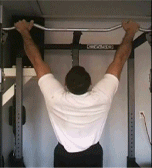It has been suggested that this article be merged into Calisthenics . (Discuss) Proposed since January 2025. |

Bodyweight exercises (also called bodyweight workouts) are strength training exercises that use an individual's own weight to provide resistance against gravity. [1] Bodyweight exercises can enhance a range of biomotor abilities including strength, power, endurance, speed, flexibility, coordination and balance. [2] Such strength training has become more popular among recreational and professional athletes. [2] Bodyweight training uses simple abilities like pushing, pulling, squatting, bending, twisting and balancing. [2] Movements such as the push-up, the pull-up, and the sit-up are among the most common bodyweight exercises. [3]
